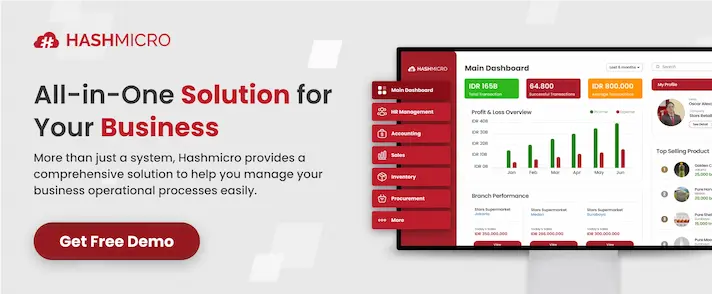Inventory control and planning are vital for my business since they often represent one of the most significant operational expenses. With proper inventory management, I can maintain smooth operations and prevent unnecessary losses.
I use HashMicro’s Inventory Management System to optimize stock, streamline planning, and maintain efficient control. Based on a Logistics Management study, automated solutions like this also help reduce stock errors and improve order fulfillment.
I’ve seen how the right system can transform efficiency and accuracy. Discover its benefits, challenges, and best practices. Try a free demo today to experience the difference yourself!
Key Takeaways
|
What is Inventory Control and Planning?
In my business, inventory planning is the process I use to determine the optimal quantity and timing of stock. My goal is to align these plans with the company’s production capacity and sales targets.
In most cases, the inventory planning process will affect the company. For instance, it directly determines any organization’s cash flow and profit margins, particularly concerning businesses that rely excessively on quick turnovers of materials and goods.
It should come as no surprise that proper inventory planning is an essential component of the success of any company.
The Importance of Inventory Control and Planning
Inventory is one of my business’s most valuable assets, so proper planning and control are essential. It helps me maintain smooth operations, respond to demand fluctuations, and stay flexible in production.
Additionally, a study by the National Retail Federation (NRF) highlights that businesses implementing practical inventory strategies experience improved profitability and reduced waste, thereby ensuring long-term sustainability.
The following are reasons why it is crucial to control and plan your inventory:
1. Sales growth
Effective inventory planning and control boost sales and profits by improving turnover rates and financial stability. Managing inventory wisely ensures better cash flow and a stronger overall business position.
2. Enhance cash flow
Inventory planning and control improve cash flow and profitability by balancing stock purchases with sales. Proper management prevents excess inventory, reducing financial strain and optimizing cash flow.
Also read: 4 Ways Inventory Systems Increase Sales in a Retail Business
3. Storage optimization
Effective inventory control enhances profitability by optimizing storage design and layout. Properly organizing high-demand items reduces travel time and improves operational efficiency.
Also read: Upscaling Your Retail Business Using Inventory Automation
4. Increase customer satisfaction
Providing excellent customer service is essential for driving sales and loyalty. Implementing innovative inventory control policies enhances accuracy, shortens lead times, and boosts customer satisfaction.
5. Optimize operational efficiency
Inventory control and planning within PPIC ensure optimal stock levels, align production schedules, and prevent disruptions to operations. This integration streamlines workflows, reduces waste, and enhances overall manufacturing efficiency.
The Goals of Inventory Control and Planning

Aside from making money, my primary goal as a business owner is to satisfy my customers. When customers are satisfied, they tend to remain loyal, and retaining them costs significantly less than acquiring new ones. By effectively controlling and planning my inventory, I can achieve even more business goals, such as improved efficiency and profitability.
-
Forecasting
Also known as inventory estimation, it is a process that uses a marketing plan to predict future sales and, as a result, future inventory requirements. Forecasting’s partner is inventory control, which counts and keeps track of inventory items to learn how they are used and keep the right amount of stock on hand. Forecasting and inventory control go hand in hand.
2. Cost Control
Inventory costs, also known as holding and storage costs, can account for 20-30% of your total business costs. Controlling costs can include buying the items, taxes, labor to receive and put away inventory, insurance, security, and even stock obsolescence, which is stock that is no longer needed, is old, or is in excess. The goal of planning inventory is to cut all of these costs.
3. Optimal utilization of space
You can positively impact the bottom line with well-designed storage facilities and by iterating the layout and design over time. The ultimate use of inventory in manufacturing, production, or fulfillment will influence the layout.
One reason you should group high-demand items is to reduce travel time. In this case, high demand refers to frequently requested items rather than a large number of items.
Benefits of Inventory Control and Planning
From my experience, effective inventory control and planning bring countless advantages to business operations. They not only streamline processes but also help me maintain optimal stock levels and maximize profitability.
1. Improving cash flow
Inventory planning and control help manage cash flow by regulating spending and optimizing stock purchases. Acquiring low-cost inventory improves liquidity and gives businesses a competitive cost advantage.
Also read: Choosing Inventory Tracking System? Here are some tips for you!
2. Gaining more profits
Effective inventory planning and control boost profits by aligning stock with consumer demand. They also minimize obsolete inventory, preventing unnecessary write-offs and financial losses.
3. Prevents abuse
Inventory policies and procedures keep employees from misusing or abusing inventory. Employees may steal inventory items for personal use or reasons in the workplace, making the company suffer a financial loss due to stolen inventory. Note that employee behavior is essential in inventory cash flow and profitability.
How to Make an Excellent Inventory Plan?
When creating an inventory plan, I focus on accuracy, efficiency, and alignment with business objectives. A well-crafted plan helps me anticipate demand, minimize waste, and ensure smooth operations.
1. Look at the volume of the product
When creating an inventory plan, business forecasting comes in handy. It will be much easier to devise a methodology to plan and maintain your inventory levels once you understand the market demand for your product.
2. Watch inventory factors
Well-planned advertising, your competition’s price cuts, and offerings, the income and context of your target market, seasonal demand, trends, and customer preferences are all factors that influence demand.
3. Maintain warehouse productivity
Managing a well-organized storage space for your goods is critical to maintaining an optimal inventory level. It is not easy to do it if you still use manual procedures while doing so.
However an Inventory Management System will help you quickly identify, track, and place orders for new deliverables and keep track of when the product is running low.
This inventory management system lets you balance your demand and supply and reduces the cost of transporting goods.
4. Automation during inventory processes
Automating various business processes will be highly beneficial when developing an inventory plan, as there will be fewer errors and greater accuracy in reports.
The help of the Automation Inventory System simplifies all the inventory planning and controlling, making it possible for you to develop an excellent inventory plan and generate more profits.
Also read: Advantages of Inventory Management Software for Construction
Challenges of Inventory Control and Planning

From my experience, inventory planning involves many variables and elements that require careful attention. Even with just one sales channel, I find that managing and forecasting inventory can be time-consuming and complex, often presenting several challenges along the way.
1. Inconsistent data
Effective inventory control and planning rely on accurate data from multiple sources, but manual processes often cause errors and inefficiencies. An Inventory Management System simplifies data collection and reporting, improving forecasting accuracy.
2. Inaccurate guesswork
Making accurate forecasts now requires more effort. The inability to accurately predict how market conditions will evolve is another factor that can make forecasting more difficult.
3. Too many branches and locations
Distributing goods across multiple locations can be challenging without proper tracking. A reliable inventory system ensures accurate allocation, reducing transport costs, delays, and inefficiencies in the supply chain.
4. Human errors
Managing your inventory, especially with several branches, can be prone to human errors. But your company can achieve its full potential with the inventory software. Such software will help you manage, control, and track inventory automatically without hiccups.
“Effective inventory control and planning are the backbone of operational efficiency, enabling businesses to minimize waste, reduce costs, and ensure products are always available when customers need them.”
— Lusiana Lu, Chief Business Development Officer
Also read: Why Should You Choose Inventory Software to Optimize Business?
Conclusion
Effective inventory control and planning are vital for business success, ensuring smooth operations and optimized cash flow. Cloud-based inventory enables real-time tracking, minimizes errors, and boosts efficiency.
Inventory management often struggles with data inconsistencies and inaccurate forecasting, but automation can help resolve these issues. An integrated Purchase Order Processing System streamlines procurement and prevents overstocking or stockouts.
I utilize HashMicro’s Inventory Management System to automate processes and optimize stock levels, which enables me to enhance accuracy and profitability. Its advanced technology has given my business long-term efficiency and a strong competitive edge.
You can also explore its features by trying the free demo today!
Warning: Undefined array key "med" in /home/hashmicr/public_html/blog/wp-content/plugins/insert-headers-and-footers/includes/class-wpcode-snippet-execute.php(419) : eval()'d code on line 281

FAQ About Inventory Control and Planning
-
-
How Does Technology Enhance Inventory Control and Planning?
Technology significantly improves efficiency and accuracy in inventory management through software systems that enable real-time stock monitoring, automated reordering, and data analysis for demand forecasting. Advanced technologies such as RFID and barcodes streamline item tracking, minimize human errors, and reduce operational costs. By leveraging automation and data-driven insights, businesses can optimize inventory levels, prevent stockouts or overstocking, and enhance overall supply chain performance.
-
What Is the Role of Inventory Control and Planning in the Supply Chain?
Inventory control and planning ensure timely product availability, minimize storage costs, and enhance operational efficiency. Effective integration with production and distribution processes enables businesses to respond swiftly to market demand, reduce lead times, and improve customer satisfaction. A well-managed inventory system strengthens supply chain resilience, enhances cash flow management, and boosts overall business competitiveness.
-
How to Integrate an Inventory Control System with ERP Software?
Integrating inventory control with ERP software begins with analyzing business needs and selecting a suitable ERP system. Next, accurate data migration is essential to ensure proper stock record management. To maximize system effectiveness, employee training is crucial for seamless adoption. After implementation, testing and evaluation are conducted to verify system functionality and optimize performance. This integration allows real-time stock monitoring, improves operational efficiency, and mitigates the risks of overstocking or stockouts, which directly impact storage costs and cash flow management.
-

































